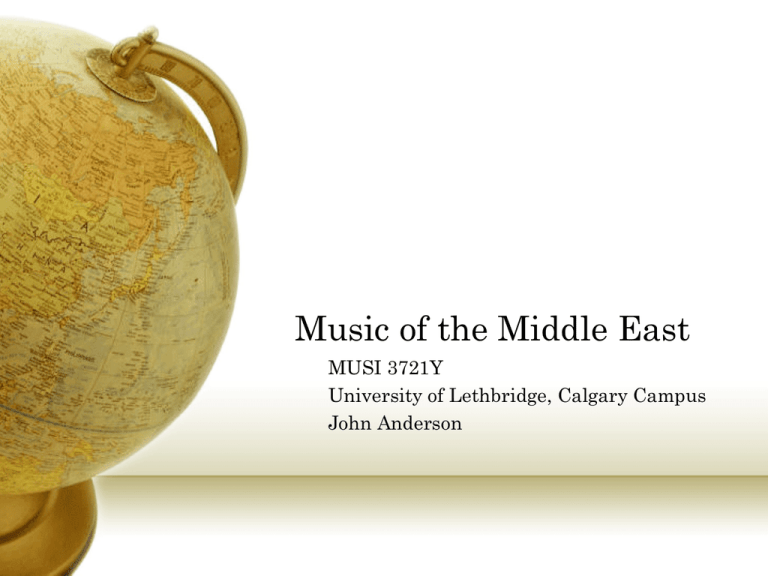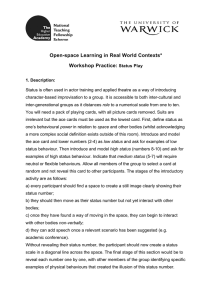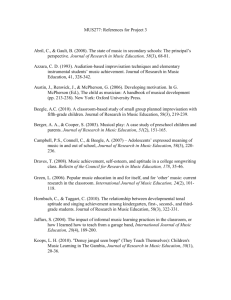Music of the Middle East MUSI 3721Y University of Lethbridge, Calgary Campus
advertisement

Music of the Middle East MUSI 3721Y University of Lethbridge, Calgary Campus John Anderson Chanting or Singing of the Holy Koran • In formal situations is always sung • Always in Arabic • Non-metric • No instrumental accompaniment • The more a performance is like the Koran’s actual sound, structure and social context, the more acceptable, and less likely considered “music” (musiqi) Chahar Mezrab in Mahour (Excerpt) from Iran Faromarz Payvar, Santour • • • • Steady meter Rhythmic predictability Repeated patterns Energetic intro on bass strings establishes regular beat Illustrations of Major Maqams • Includes a number of the most important Arabic maqams • Telling them apart is not easy for the uninitiated listener • Rast sounds slightly out of tune to Western ears • Hijazkar sounds sad and exotic to Westerners • Saba sounds compressed • Sika sounds ambiguous • Nahawand comparable to a Western minor scale Examples of Metric, Non-Metric and Mixed Meters in Music • Free rhythm • Iranian Radif of Nour-Ali Boroumand (except) • Sections with regular beat, but no overall meter • Arabic Taqsim Nahwawand • Some metric structure • Arabic Ya Zalmni (except) • • • • Repeated rhythmic patterns Iranian Improvisation on Daramad of Chahargah (0:00-0:27) Regular, driving rhythm Iranian Chahar Mezrab in Mahour (excerpt) Taqsim in the Mawam of Nahawand • • • • • • • • • • Begins in the lower range Moderate tempo Gradually moves higher Moves down to a characteristic closing Pauses Two brief notes used to transition Some musical gestures repeated from opening But as a whole pitched higher Moves more rapidly Jumps between high and low notes more quickly Six Excerpts of Improvisation Based on the Daramad of Chahargah • Santour • • • • Strong kreeshmeh rhythm Appears three times in a row Deliberate tempo Dramatic pause • Kamacheh • Metric • Begins slow, lyrical • Violin • • • • • Non-metric Low-pitched Deliberated Lots of rubato (robbing the time) and ornamentation Pizzicato (lightly plucked notes) Six Excerpts of Improvisation Based on the Daramad of Chahargah • Violin • Non-metric • Similar to previous improv • Double stops at 2:15 and 2:20 • Setar • • • • • Metric Chahar, mezrab style Changeable mood Moves to slow, lyrical style Changes to rapid Chahar mezrab • Setar • Kereshmeh rhythm at 4:00 and 4:12 • Strong rhythms emphasized Ya zalimni (excerpt) • Sung by Umm Kulthum • Gained prominence after WWII • Contradicted Islamic ambivalence toward music in general and women in particular • Orchestral accompaniment • Voice paralleled by string section • Flute and Middle Eastern percussion • Fades in on first verse • Informal call and response between singer and audience Discussion Questions • On a sliding scale, as between khandan and musiqi, where can we place different types of North American music, from church hymns to punk rock? • What are some similarities between Middle Eastern and Indian music improvisation? • What are the differences between Middle Eastern and Indian ensemble textures? Discussion Questions • What are similarities and differences between Middle Eastern chordophones and chordophones found elsewhere throughout the world? • How can Middle Eastern music improvisation be compared to jazz or blues? • What is the commonality of beliefs between Christianity, Hinduism and Islam, concerning the origin of their vocal and instrumental music?



